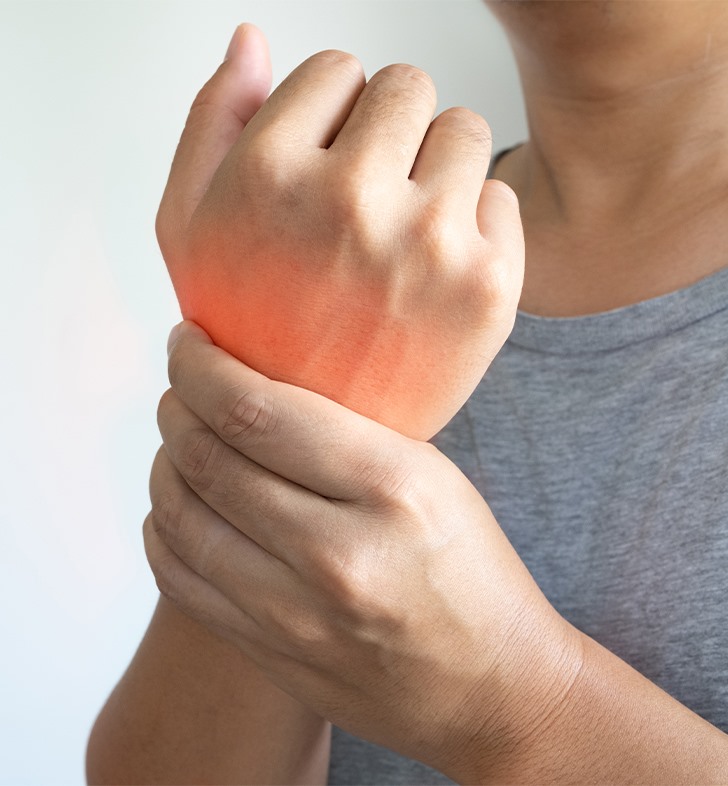
Arthritis
What is arthritis? Arthritis is a disease that affects your joints (areas where your bones meet and move). Arthritis usually involves inflammation or degeneration (breakdown) of your joints. These changes can cause pain when you use the joint. Arthritis is most common in the following areas of the body: Feet. Hands. Hips. Knees. Lower back.
What are the parts of a joint? Joints get cushioned and supported by soft tissues that prevent your bones from rubbing against each other. A connective tissue called articular cartilage plays a key role. It helps your joints move smoothly without friction or pain. Some joints have a synovial membrane, a padded pocket of fluid that lubricates the joints. Many joints, such as your knees, get supported by tendons and ligaments. Tendons connect muscles to your bones, while ligaments connect bones to other bones.
What are the different types of arthritis? Arthritis is a broad term that describes more than 100 different joint conditions. The most common types of arthritis include: Osteoarthritis, or “wear and tear” arthritis, which develops when joint cartilage breaks down from repeated stress. It’s the most common form of arthritis. Ankylosing spondylitis, or arthritis of the spine (usually your lower back). Juvenile arthritis (JA), a disorder where the immune system attacks the tissue around joints. JA typically affects children 16 or younger. Gout, a disease that causes hard crystals of uric acid to form in your joints. Psoriatic arthritis, joint inflammation that develops in people with psoriasis (autoimmune disorder that causes skin irritation). Rheumatoid arthritis, a disease that causes the immune system to attack synovial membranes in your joints.
How common is arthritis?
Arthritis is the most common cause
of disability in the U.S. About 50 million adults and 300,000 children manage
some form of arthritis.
What causes arthritis?
Different types of arthritis have
different causes. For instance, gout is the result of too much uric acid in
your body. But for other types of arthritis, the exact cause is unknown. You
may develop arthritis if you:
- Have a family history of arthritis.
- Have a job or play a sport that puts
repeated stress on your joints.
- Have certain autoimmune diseases or
viral infections.
What are the risk factors for
arthritis?
Some factors make you more likely to
develop arthritis, including:
Age: The risk of arthritis increases
as you get older.
Lifestyle: Smoking or a lack of
exercise can increase your risk of arthritis.
Sex: Most types of arthritis are
more common in women.
Weight: Obesity puts extra strain on
your joints, which can lead to arthritis.
What are the symptoms of arthritis?
Different types of arthritis have
different symptoms. They can be mild in some people and severe in others. Joint
discomfort might come and go, or it could stay constant. Common symptoms
include:
- Pain.
- Redness.
- Stiffness.
- Swelling.
- Tenderness.
- Warmth.
How is arthritis diagnosed?
If you think you may have arthritis,
see your healthcare provider. The provider will ask about your symptoms and
learn how joint pain affects your life. Your provider will perform a physical
exam, which may include:
- Assessing mobility and range of
motion in your joints.
- Checking for areas of tenderness or
swelling around your joints.
- Evaluating your overall health to
determine if a different condition could be causing your symptoms.
Can imaging exams detect arthritis?
Imaging exams can help your
healthcare provider get a clear picture of your bones, joints and soft tissues.
An X-ray, MRI or ultrasound can reveal:
- Bone fractures or dislocations that
may be causing you joint pain.
- Cartilage breakdown around your
joints.
- Muscle, ligament or tendon injuries
near your joints.
- Soft tissue inflammation.
Can a blood test detect arthritis?
There is no blood test that can
directly detect arthritis. But if your healthcare provider suspects gout or
rheumatoid arthritis, they may order blood work. It looks for uric acid or
inflammatory proteins.
How is arthritis treated?
There’s no cure for arthritis, but
there are treatments that can help you manage the condition. Your treatment
plan will depend on the severity of the arthritis, its symptoms and your
overall health.
Conservative (nonsurgical)
treatments include:
Medication: Anti-inflammatory and
pain medications may help relieve your arthritis symptoms. Some medications,
called biologics, target your immune system’s inflammatory response. A
healthcare provider may recommend biologics for your rheumatoid or psoriatic
arthritis.
Physical therapy: Rehabilitation can
help improve strength, range of motion and overall mobility. Therapists can
teach you how to adjust your daily activities to lessen arthritic pain.
Therapeutic injections: Cortisone
shots may help temporarily relieve pain and inflammation in your joints.
Arthritis in certain joints, such as your knee, may improve with a treatment
called viscosupplementation. It injects lubricant to help joints move smoothly.
Will I need surgery for arthritis?
Healthcare providers usually only
recommend surgery for certain severe cases of arthritis. These are cases that
haven’t improved with conservative treatments. Surgical options include:
Fusion: Two or more bones are
permanently fused together. Fusion immobilizes a joint and reduces pain caused
by movement.
Joint replacement: A damaged,
arthritic joint gets replaced with an artificial joint. Joint replacement
preserves joint function and movement. Examples include ankle replacement, hip
replacement, knee replacement and shoulder replacement.